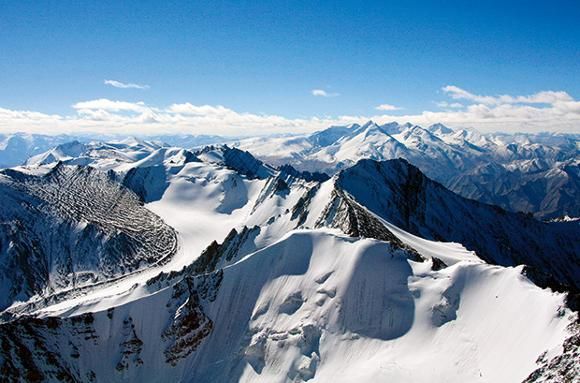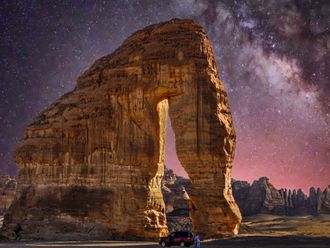
I’d been warned about it; the swirling black hole that sucks away all breath, body warmth and rational thinking. But here I am, coiled tightly into a ball like a startled millipede at the bottom of my sleeping bag, struggling to gasp the thin, icy air that circulates the mountain tops at 3,700m above sea level, while reminding myself exactly why I’ve chosen to camp in temperatures that dip to a mind-numbing -27°C at night.
Only the sound of hulking yaks snuffling for scant vegetation, metal bells clanging around their necks, is a welcome reminder that life can, against the odds, exist here.
Harsh, hostile but overwhelmingly beautiful, the Himalayan mountain range is a fitting habitat for one of the world’s most elusive and endangered big cats: the snow leopard. According to estimates from the International Union for the Conservation of Nature, there are between 4,000 and 6,500 of these mountain ghosts left in the wild, encompassing a range of 12 central Asian countries.
Coy, aloof and enigmatic creatures, they are notoriously difficult to spot, and at their home on the roof of the world, they rarely entertain visitors.
But one of the most accessible and opportune places to see snow leopards is Hemis National Park in the eastern Ladakh region of India’s Jammu and Kashmir state. Accessible, though, is a word used relatively.
During the summer months, the park’s green valleys become a magnet for soul-searching backpackers and hardy trekkers heading to the Stok Kangri peak, but in February and March, when temperatures plummet like a skydiver in freefall, the crowds disappear. Yet this is the time when blue sheep drop down from mountains, pursued by hungry snow leopards, who in turn attract wildlife tourists in search of their quarry.
After landing amidst the snowy jagged peaks of the military airport at Ladakhi capital Leh – a reminder of our proximity to the Pakistan border – we drive into the granite folds until we reach the end of the road.
From here, our belongings are piled on to donkeys, and we slip and stumble along a frozen river, grabbing on to the frail skeletons of willow trees for balance.
Our simple eight-tent camp is in the Husing Valley, with no running water or electricity, and the toilet is essentially a hole in the frosty ground.
Snow leopard tourism is still in its infancy, and capturing the cats on film or video has become a holy grail for wildlife enthusiasts. When National Geographic photographer Steve Winter published camera trap images of the animals in 2008, interest in Hemis was piqued, and in the past few years, winter visitors have increased from a handful to a hundred. My guide, Paul Goldstein, an award-winning wildlife photographer with a fascination for predators, became hooked when he first visited Hemis last year – even though he didn’t see a single cat.
The conditions are punishing and the odds are stacked against us, but even the knowledge that these mountain ghosts might have drifted along the same ridge where I’m now sitting causes my heart to race with excitement.
Early every morning, before sunrise, a team of eagle-eyed spotters recruited from nearby villages heads out to set up spotting scopes, searching for the 10 snow leopards that roam this valley. Being crepuscular, dawn and dusk are the best times to catch the cats on the move.
With radio signals limited, communication is mainly human, and news of sightings is delivered by resilient messengers who sprint with remarkable ease at such high altitude. After combing ice crystals from my hair and applying heat pads to every extremity, I set off to join them. Struggling to gain any purchase on the loose scree, every footstep feels arduous, and as we gain altitude, my breath quickens.
Overhead, hardy lammergeier vultures circle the fractured mountain peaks. Having chosen our vantage point, we pull out binoculars and wait. Then we wait some more. The sun now out, the temperature has risen to a tropical four degrees.
Paul amuses us with games and jokes, shooting the breeze with delightfully tasteless punchlines. And when we tire of talking, we sit and appreciate the silence, broken only by the ringing call of red-billed choughs.
Remembering that it took the BBC’s Planet Earth team three years to get decent video footage of snow leopards, I realise that a trip of this nature requires some serious patience.
One of our spotters, Jigmid, tells us that snow leopards have been known to venture into villages, destroying livestock. At one time, they would have been shot, but that now carries a hefty prison sentence.
After six hours, we’ve seen nothing, save for a few blue sheep kicking up dust storms as they scamper down bone-dry precipices. So as stars begin to light up the night sky, we head back to camp, huddle around a gas heater and play cards.
Every night, the support team prepares an impressive feast – including chapatis, pizzas and even a chocolate cake iced with leopard paw prints.
The following morning, though, we awake to welcome news – a snow leopard has been spotted close to the camp. Tugging on base layers and pulling a down jacket over my pyjamas, I pick up my camera and race out. With no food and little sleep, I’m exhausted, and rely on our wonderful porters to haul me up the last few metres.
Ahead of me, cumbersome camera lenses form an arc along the ridge. And then she appears on the horizon, silhouetted against the blue daybreak sky, and flanked by her two princes, both one-year-old juveniles. Standing before us is a third of the valley’s snow leopard population.
Paul is beyond desperate and breaks his tooth trying to set up his tripod in haste.
Using their muscular, bushy tails for balance, the trio drop down sheer escarpments and leap between ridges, traversing gaps several times their body length. Against a mottled backdrop of the sandy rock, their camouflage is incredible and we struggle to keep sight of them.
Finally, they settle in a cave, and even though they are 2km away, the excitement is palpable.
We stand on a snowy 45-degree angle slope for seven hours, watching and becoming intimately familiar with every crag, crevice and contour on the rock face, until the sun falls behind the mountain, pulling the plug on our electrifying show.
Although nothing more than mere specks in scopes, our sighting of snow leopards is worth more to me than any HD image beamed from a giant plasma TV screen. Because this is real.
They may appear more intangible than supernatural phenomena, but these mountain ghosts are out there somewhere. Be patient, bide your time, and there’s a chance you might see one.



_resources1_16a08544951_small.jpg)








